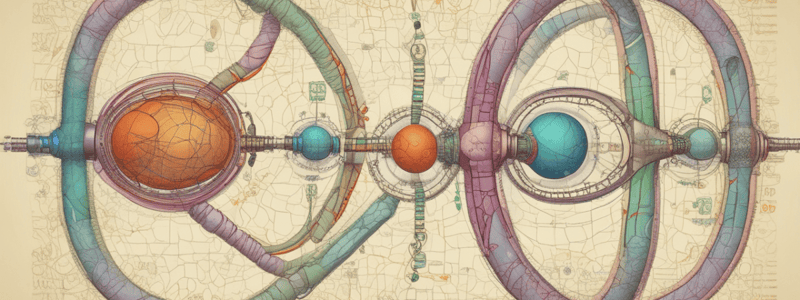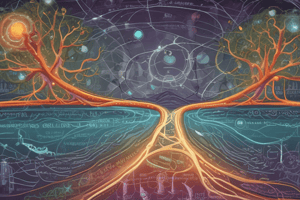Podcast
Questions and Answers
What is the primary purpose of glucose-6-phosphate in glycolysis?
What is the primary purpose of glucose-6-phosphate in glycolysis?
- To synthesize glycogen
- To produce NADPH for fatty acid synthesis
- To provide energy for the cell during energy demand (correct)
- To initiate the pentose-phosphate pathway
What happens to pyruvate in the absence of oxygen?
What happens to pyruvate in the absence of oxygen?
- It is converted to oxaloacetate
- It is converted to glucose-6-phosphate
- It is converted to Acetyl-CoA
- It is converted to lactate (correct)
What is the purpose of compartmentalization in controlling metabolic processes?
What is the purpose of compartmentalization in controlling metabolic processes?
- To promote covalent modifications
- To regulate enzyme activity
- To separate metabolic pathways (correct)
- To facilitate allosteric regulation
What is the result of transamination with pyruvate?
What is the result of transamination with pyruvate?
Why are three reactions of glycolysis considered irreversible?
Why are three reactions of glycolysis considered irreversible?
What is the purpose of gluconeogenesis?
What is the purpose of gluconeogenesis?
What is the relationship between glycolysis and gluconeogenesis?
What is the relationship between glycolysis and gluconeogenesis?
What is the purpose of glycogen synthesis?
What is the purpose of glycogen synthesis?
What is the effect of insulin on glycogen metabolism in the liver and muscle?
What is the effect of insulin on glycogen metabolism in the liver and muscle?
What is the primary source of energy for the heart during long-term reduced energy supply?
What is the primary source of energy for the heart during long-term reduced energy supply?
Which of the following enzymes is NOT involved in gluconeogenesis?
Which of the following enzymes is NOT involved in gluconeogenesis?
What is the effect of insulin on protein metabolism?
What is the effect of insulin on protein metabolism?
What is the primary source of energy during early stages of reduced energy supply?
What is the primary source of energy during early stages of reduced energy supply?
What is the effect of glucagon on glycogen metabolism in the liver?
What is the effect of glucagon on glycogen metabolism in the liver?
Which of the following organs is responsible for the secretion of insulin and glucagon in response to changes in blood glucose levels?
Which of the following organs is responsible for the secretion of insulin and glucagon in response to changes in blood glucose levels?
What is the effect of insulin on the synthesis of fatty acids?
What is the effect of insulin on the synthesis of fatty acids?
What percentage of the body's oxygen consumption is attributed to the brain?
What percentage of the body's oxygen consumption is attributed to the brain?
What is the approximate amount of glucose consumed by the brain per day?
What is the approximate amount of glucose consumed by the brain per day?
What is the percentage of body weight accounted for by the brain?
What is the percentage of body weight accounted for by the brain?
What is true about the brain's energy demand?
What is true about the brain's energy demand?
What is the primary source of energy for the brain?
What is the primary source of energy for the brain?
What is the primary function of the portal vein?
What is the primary function of the portal vein?
What is the primary function of adipose tissue?
What is the primary function of adipose tissue?
What is the primary function of the skeletal muscles?
What is the primary function of the skeletal muscles?
What is the substrate for the Krebs cycle?
What is the substrate for the Krebs cycle?
What is the result of Acetyl-CoA oxidation in the Krebs cycle?
What is the result of Acetyl-CoA oxidation in the Krebs cycle?
What is the role of Acetyl-CoA in cellular metabolism?
What is the role of Acetyl-CoA in cellular metabolism?
What is the primary function of the pentose-phosphate pathway?
What is the primary function of the pentose-phosphate pathway?
Where is glycogen primarily stored in the body?
Where is glycogen primarily stored in the body?
What is the effect of insulin on glycogen synthesis?
What is the effect of insulin on glycogen synthesis?
What is the role of anaplerotic pathways in the Krebs cycle?
What is the role of anaplerotic pathways in the Krebs cycle?
What is the opposing hormone to insulin in terms of glucose regulation?
What is the opposing hormone to insulin in terms of glucose regulation?
What is the primary source of energy for the brain in a normal condition?
What is the primary source of energy for the brain in a normal condition?
What is the purpose of the sodium-potassium pump in the brain?
What is the purpose of the sodium-potassium pump in the brain?
What is the percentage of acetone in ketone bodies?
What is the percentage of acetone in ketone bodies?
In a situation of reduced glucose supply, what can partially take over the role of glucose in the brain?
In a situation of reduced glucose supply, what can partially take over the role of glucose in the brain?
What is the percentage of oxygen consumed by muscles at rest?
What is the percentage of oxygen consumed by muscles at rest?
What is the purpose of ATP in muscle relaxation?
What is the purpose of ATP in muscle relaxation?
What is the fate of β-hydroxybutyrate in the brain?
What is the fate of β-hydroxybutyrate in the brain?
What is the site of ketone body formation?
What is the site of ketone body formation?
Study Notes
Integration of Metabolic Processes
- All metabolic (and non-metabolic) processes are integrated (or at least interact with each other) in the body.
- The integration of metabolic processes should be considered at two levels: cellular and tissue/whole organism.
Control of Metabolic Processes
- Allosteric regulation, covalent modifications, enzyme regulation, compartmentalization, and metabolic specialization of organs are ways to control metabolic processes.
- Integration of metabolic processes should be considered at two levels: cellular and tissue/whole organism.
Major Metabolic Pathways and their Key Metabolites
Glycolysis
- Glucose-6-phosphate is a critical point in glycolysis and has many possible "fates".
- Pyruvate is the product of glycolysis and a turning point of metabolism depending on the oxidative state of the cell.
- In the absence of oxygen, pyruvate is converted to lactate.
- In the presence of oxygen, pyruvate is converted to Acetyl-CoA.
- Pyruvate can also undergo transamination with the formation of alanine or carboxylation with the formation of oxaloacetate.
Gluconeogenesis
- Gluconeogenesis is a reversal of glycolysis.
- To carry out gluconeogenesis, three reactions of glycolysis must be bypassed: glucose -> glucose 6 phosphate, fructose 6 phosphate -> fructose 1,6 bis phosphate, and phosphoenolpyruvate -> pyruvate.
- Glycolysis and gluconeogenesis are regulated simultaneously, with factors that promote glycolysis simultaneously inhibiting gluconeogenesis, and vice versa.
Krebs Cycle
- Acetyl-CoA is the central compound of all metabolism.
- The Krebs cycle is the oxidation of Acetyl-CoA to two molecules of CO2, regenerating oxaloacetate and producing ATP, NADH, and FADH2.
- Acetyl-CoA can be produced from pyruvate, fatty acid beta-oxidation, or ketogenic amino acid catabolism.
- Anaplerotic pathways rebuild Krebs cycle intermediates.
Pentose-Phosphate Pathway
- The pentose-phosphate pathway produces ribose-5-phosphate for nucleotide synthesis and NADPH for reductive biosynthesis.
Glycogen Synthesis and Degradation
- Glycogen is a "medium-term" form of energy storage located in the liver and muscles.
Antagonistic Effect of Insulin and Glucagon
- Insulin promotes glucose uptake, glycogen synthesis, and fatty acid synthesis, while inhibiting glycogen degradation, gluconeogenesis, and fatty acid mobilization.
- Glucagon has the opposite effects, promoting glycogen degradation, gluconeogenesis, and fatty acid mobilization, while inhibiting glycogen synthesis and fatty acid synthesis.
Adaptation of Metabolism to Reduced Energy Supply
- In the early stage of reduced energy supply (fasting, >2 days), glycogenolysis and gluconeogenesis are the main sources of glucose.
- In the intermediate stage of reduced energy supply (prolonged fasting, up to about 3 weeks), glycogen is virtually depleted, and fatty acid beta-oxidation and ketone body production become the main sources of energy.
- In the long-term reduced energy supply (starvation, more than 3 weeks), protein protection is prioritized, with the transport of lactate and alanine from muscle to liver for glucose synthesis.
Metabolic Specialization of Organs
- The brain has a high energy demand and relies on glucose and ketone bodies for energy.
- The liver processes ingested sugars, proteins, and fats, and synthesizes and distributes lipids, ketone bodies, and glucose.
- Adipose tissue is responsible for lipid synthesis, storage, and mobilization.
- Skeletal muscles have a high ATP demand for muscle contraction and relaxation.
Other Key Points
- The pancreas secretes insulin and glucagon in response to changes in blood glucose levels.
- The portal vein transmits nutrients from the intestine to the liver.
- The small intestine absorbs nutrients and transfers them to the bloodstream.
Studying That Suits You
Use AI to generate personalized quizzes and flashcards to suit your learning preferences.
Related Documents
Description
This quiz covers the integration of metabolic processes at the cellular and tissue/whole organism levels, as well as the control mechanisms such as allosteric regulation, covalent modifications, and enzyme regulation. It explores how metabolic processes interact with each other in the body.



